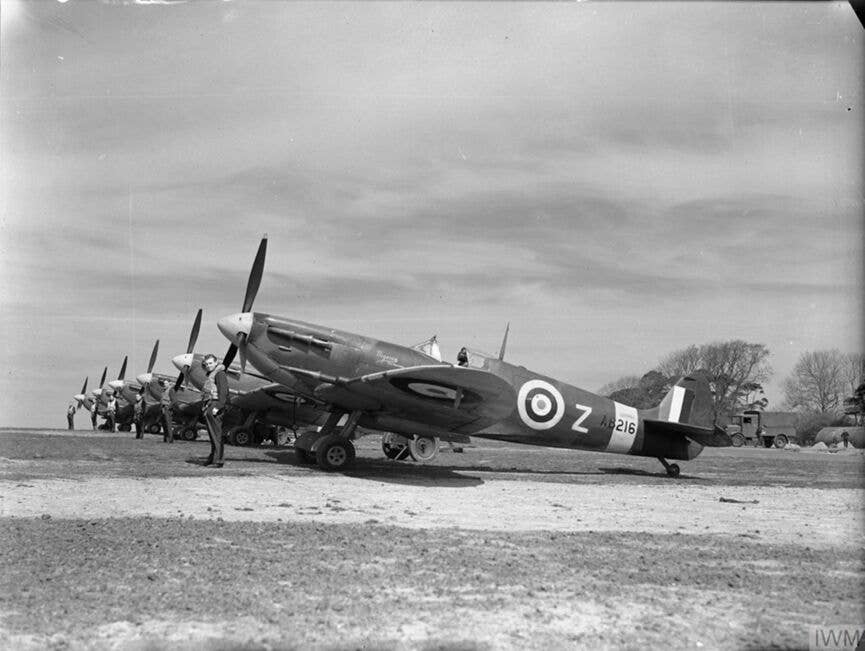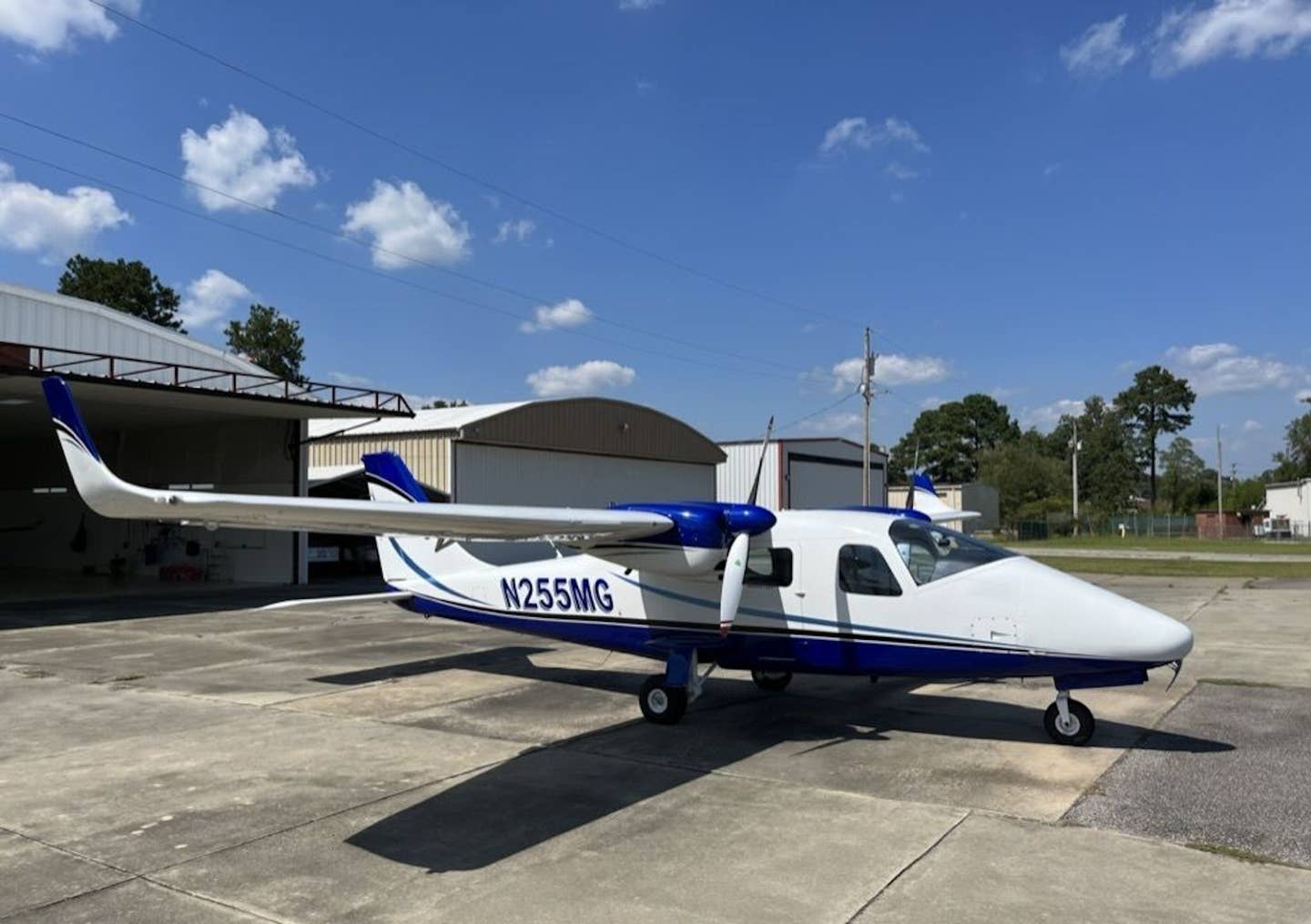Spitfires Served as Heroes of the Battle of Britain
The Spitfire was critical in defeating Luftwaffe air attacks for the Royal Air Force (RAF) during the Battle of Britain.

A squadron of Spitfires [Courtesy: Imperial War Museum]
Historians have described the Battle of Britain as the first major military campaign fought entirely by air forces. The battle began on July 10, 1940, and lasted until October 31, overlapping the large-scale night attacks known as the Blitz (September 7, 1940, to May 11, 1941).
During the Battle of Britain, the Royal Air Force (RAF) and the Fleet Air Arm of the Royal Navy defended Great Britain against large-scale attacks by Nazi Germany's Luftwaffe (air force) in a duel for air superiority over southern England.
Germany’s primary objective was to compel Great Britain to agree to a negotiated peace settlement. In July 1940, Germany’s air and sea blockade began; the Luftwaffe targeted coastal shipping convoys, ports, and shipping centers. On August 1, the Luftwaffe was ordered to gain air superiority over the RAF and incapacitate the RAF Fighter Command. On August 13, the attacks shifted to target RAF airfields and infrastructure. As the battle continued, the Luftwaffe also targeted aircraft production factories and strategic infrastructure. During the Blitz, the Germans used terror bombing on politically significant areas and civilians.
A single-seat, short-range, high-performance interceptor aircraft, the “Supermarine Spitfire was critical in defeating Luftwaffe air attacks during the Battle of Britain,” according to the RAF. During 1940, the Spitfire became a symbol of defiance and freedom for the British.
“Pilots on both sides were at the controls of some of the most iconic aircraft in aviation history, including the Spitfire, Hurricane, and Messerschmitt Bf 109,” as told by the Imperial War Museum. Because of the Spitfire’s superior high-altitude performance, it is considered by many as the airplane that provided the margin of victory, although more Hurricanes were involved and credited with more “kills.”
The Spitfire’s Design
In the early and mid-1930s, aviation design teams developed the next generation of fighters. New techniques used monocoque (French for “single shell”) construction, a structural system used in airframes, in which loads are supported by the aircraft’s external skin, much like an egg shell. Examples from the time period include the French Dewoitine D520 and the German Messerschmitt 109—and monocoque construction became primary for light airplane design in the post-war years.
In addition, new high-powered, liquid-cooled, in-line engines developed around the same time. Aircraft designers also incorporated retractable landing gear, fully enclosed cockpits, and low-drag, all-metal wings. Although engineers had introduced these advances on civilian airliners, the military adopted them more slowly, as it favored the simplicity and maneuverability of biplanes.
In 1934 the Air Ministry sought a new, high-performance fighter for the RAF. Reginald Mitchell, the chief designer at Supermarine Aviation Works, designed the Spitfire—it was a variant of floatplanes he designed in the 1920s.
Mitchell’s high-performance fighter exploited the power of the Merlin engine, while also being relatively easy to fly. To fulfill a home defense mission, the Spitfire could climb quickly to intercept enemy fighters and bombers.
Mitchell and his design staff used a semi-elliptical wing shape to solve conflicting requirements. The wing had to be thin to create less form drag, but thick enough to house the retractable landing gear, armament, and ammunition. According to Beverley Shenstone, the aerodynamicist on Mitchell's team, “the elliptical wing was… aerodynamically… the best for our purpose because the induced drag caused in producing lift was lowest when this shape was used.”
Mitchell’s Spitfire featured an advanced aluminum airframe, making it light and strong. Its elliptical wing had innovative sunken rivets, designed by Shenstone so that the wing would have the thinnest possible cross-section.
While it took longer to build a Spitfire than a Hurricane (and it was less durable), it was faster and more responsive. The Merlin’s efficient two-stage supercharger also gave Spitfires exceptional performance at high altitudes.
The Spitfire prototype flew in March 1935. Because of its outstanding performance and flight characteristics, the Air Ministry ordered 310 Spitfires on June 3, 1936. Mitchell continued to refine the Spitfire’s design until his death in 1937. His colleague Joseph Smith took over as chief designer, overseeing the many Spitfire variants.
Although full-scale production was scheduled to begin immediately, there were numerous problems, and the first production Spitfire was not manufactured until mid-1938.
As a result of the delays, the Air Ministry planned to stop Spitfire production after the initial order. However, Supermarine convinced the Ministry that production problems could be solved, and 200 additional Spitfires were ordered on March 24, 1938. Deliveries to RAF squadrons began in mid-1938 and continued throughout the war.
The Battle of Britain
The first Spitfires entered service in August 1938. When World War II began on September 1, 1939, nine RAF squadrons were equipped with Spitfires. RAF Fighter Command refused to send Spitfires to France during the German blitzkrieg of 1940, and by July 1940 there were 19 Spitfire Mark I (MkI) squadrons available.
Spitfire MkIs that fought in the Battle of Britain were powered by Merlin engines with 1,030 horsepower. The airplanes had wingspans of 36 feet, 10 inches; were 29 feet, 11 inches long; and reached a maximum speed of 360 mph and a ceiling of 34,000 feet. Generally, Spitfires engaged Messerschmitt Bf 109s, while the slower Hurricanes attacked German bombers. The Spitfires were as maneuverable and faster than the German fighters at altitudes above 15,000 feet.
Once the RAF modified its tactics, the outcome of aerial combat often depended more on a pilot’s capabilities than his aircraft. During the Battle of Britain, Spitfire pilots shot down 529 enemy aircraft, while 230 were lost.
Improvements
Supermarine developed improved Spitfire versions driven by progressively more powerful Merlins. Twenty-four Spitfire versions were built; and several wing configurations and guns were used. For example, fighter-bomber versions carried a 250- or 500-pound bomb beneath the fuselage and a 250-pound bomb under each wing. Other performance improvements were made by using new constant-speed propellers and modifying the Merlin to run on 100-octane aviation gasoline (avgas).
British production aircraft were flight-tested before delivery. Alex Henshaw was the chief test pilot at one of the several facilities where Spitfires were assembled. He assessed all Spitfire changes, and also coordinated a team of 25 test pilots. Between 1940 and 1946, Henshaw flew 2,360 Spitfires, more than 10 percent of total production.
Henshaw wrote about flight-testing Spitfires: “I loved the Spitfire in all of her many versions. …the later versions, although they were faster… were also much heavier and so did not handle as well. …an improvement at one end of the performance envelope is rarely achieved without a deterioration somewhere else.”
Other Service in World War II
Following the Battle of Britain, the Spitfire became the principal aircraft of RAF Fighter Command. It operated in several roles, including interceptor, fighter-bomber, trainer and photo-reconnaissance, and continued to do so until the 1950s. The Seafire was an aircraft-carrier-based adaptation. Fitted with tail hooks and strengthened tail sections, it was utilized in the Fleet Air Arm from June 1942 until the mid-1950s.
Spitfires were used in the European, Mediterranean, Pacific, and Southeast Asian theaters of war. They were used in the defense of Malta, in North Africa and Italy, and helped provide air superiority over the Sicily, Italy and Normandy beachheads. They also served in the Far East beginning in the spring of 1943.
Beginning in early 1941, a key role for Spitfires was as a photo-reconnaissance aircraft. In 1941 and 1942, Spitfires provided the first photographs of the Freya and Würzburg radar systems, and in 1943, helped confirm that the Germans were building the V-1 and V-2 rockets by photographing Peenemünde, on the Baltic Sea coast of Germany.
In late 1943 Spitfires powered by Rolls-Royce Griffon engines came online that were capable of top speeds of 440 mph and ceilings of 40,000 feet. These aircraft were used to shoot down V-1 “buzz bombs.”
The aircraft’s original airframe was strong enough to be fitted with increasingly powerful Merlins and eventually Rolls-Royce Griffon engines producing up to 2,340 hp. Therefore, the Spitfire’s performance and capabilities improved during its service life.
Nearly 1,200 Spitfires were delivered to the USSR, and Spitfires also were used by the U. S. Army Air Forces until they were replaced by P-47 Thunderbolts in March 1943.
Final Years
The last version of the Spitfire was the Mk 24, first flown on April 13, 1946. On February 20, 1948, almost 12 years after the prototype's first flight, the last production Spitfire was built. Spitfire Mk 24s were used in only one regular RAF unit; 80 Squadron replaced its Hawker Tempests with Mk 24s in 1947. These aircraft were relocated to Hong Kong in July 1949, and during the Chinese Civil War, their main duty was to defend Hong Kong from Communist threats.
During the Malayan Emergency, Spitfires flew over 1,800 operational sorties against Malayan Communists. The final operational sortie of an RAF Spitfire took place on April 1, 1954, by a Mk 19 Spitfire of 81 Squadron. It flew from an RAF base in Singapore to photograph a jungle area near Johor, Malaysia, thought to contain Communist guerrillas.
The last non-operational flight of a Spitfire in RAF service involved a Mk 19, and occurred on June 9, 1957, when the airplane participated in a temperature and humidity test. This was also the last known flight of an RAF piston-engined fighter.
A restored Spitfire in flight. [Courtesy: Royal Air Force]
Legacy
The Spitfire was the most strategically important British single-seat fighter of World War II. More Spitfires were built than any other British combat aircraft before or since World War II —some 20,350. Additionally, the Spitfire was the only British fighter to be in continuous production before, during and after World War II.
The aircraft was produced in more variants than any other British aircraft. These included the prototypes, those powered by various Merlin and Griffon engines, the high-speed photo-reconnaissance variants and those with several different wing configurations. There were 6,487 MkVs built (more than any other type), followed by 5,656 Mk IXs.
Different wings, featuring several different weapons, were fitted to most marks – the A wing had eight 7.7 mm machine guns; the B wing had four 7.7 mm machine guns and two 20 mm cannon; the C (or universal) wing could mount either four 20 mm cannon or two 20 mm and four 7.7 mm machine guns; and the E wing had two 20 mm cannon and two 12.7 mm machine guns.
Throughout the war, designers continued to improve the Spitfire’s speed and armament. However, its limited fuel capacity restricted the airplane’s range and endurance, except in the dedicated photo-reconnaissance role, when its guns were replaced by extra fuel tanks.
FLYING Classics thanks BAE Systems, Encyclopedia Britannica, historyhit.com, the Imperial War Museum, the Royal Air Force and the Royal Air Force Museum for information and photos that contributed to this article.

Subscribe to Our Newsletter
Get the latest FLYING stories delivered directly to your inbox






